I always keep barley in my pantry. I like adding it to soups, especially beef soup. But I’ve only used it in soups, and I know very little about it. There must be more to discover about this old grain!
And barley is old. It is officially included among the ancient grains. I go to my new-favorite site, Whole Grains Council, and learn this:
“Egyptians buried mummies with necklaces of barley, and centuries later In 1324 Edward II of England standardized the inch as equal to ‘three grains of barley, dry and round, placed end to end lengthwise.’”
Barley was domesticated around 19,000 years ago (Wikipedia). Wild barley still exists in western Asia and Northeast Africa, but domesticated barley is the type widely available today. I don’t think all the barley we get is considered an “heirloom grain” as is farro, but it is considered ancient. (Humans discovered barley and farro in the same time frame.) Today, barley is ranked as the 4th most popular grain in the world, behind maize, rice, and wheat.
There are about fifty “cultivars” of barley today. Fifty! A cultivar is a “plant variety that has been produced in cultivation by selective breeding”, according to Google’s dictionary. Most of the cultivars, or varieties, have a hull that is very tough and inedible. That hull must be removed before we can eat it. And yes, hulling the barley removes some of the nutrients. The processed form of barley called “dehulled barley” (confusingly this may also be labeled “hulled” barley) is considered a whole grain because it still has its bran and germ. According to the Old Grains Council, dehulled (or “pot”) barley is available at health food stores, but it takes a very long time to cook. Most of the barley we see in our markets is “pearl barley”. Pearl barley is dehulled barley that has been steamed to remove the bran, and then polished in a process called “pearling”. (Wikipedia). Another form of barley, “hulless” varieties (cultivars), are available through Bob’s Red Mill and Shiloh Farms (labelled either “hull-less” or “hulless”). Hulless barley never had a hull to lose! Instant or quick barley is available from Quaker Oats. It cooks in just 10 minutes.
The Old Grains Council site states “Lightly pearled barley is not technically a whole grain (as small amounts of the bran are missing) – but it’s full of fiber and much healthier than a fully-refined grain.” Is my barley “lightly pearled”? I don’t know. But, they state “While the fiber in most grains is concentrated largely in the outer bran layer, barley’s fiber is found throughout the whole grain, which may account for its extraordinarily high levels.”
I learn more about dehulled (hulled, pot), hull-less, and pearl barley on the GoBarley web site. Dehulled barley has been pearled for a shorter amount of time and still has most of the barley bran intact, but it takes a long time to cook. According to the GoBarley site: “Don’t ever think you can’t make a recipe because it calls for a different type of barley than the one you have on hand.”
So: unless you buy the instant type of barley, it will take a long time to cook, so plan ahead.
Cooked barley has a chewy texture and good flavor. It barley can be used in side dishes, salads, main dishes, soups and more – much like wheat berries, farro, and sorghum. Barley flakes and grits can be cooked into porridge. Barley is processed into flour and used in breads. Different barley products are used in commercial packaged foods.
And don’t forget gruel: barley meal is made into gruel. Gruel is a thin porridge, the stuff fed to inmates and peasants. “Eat your gruel!”
Beer! Beer and whiskey are more reasons why barley is so popular world-wide. How is that? Barley is made into malt! I learned this when I covered malt syrup in one of my posts in 250 Cookbooks, Blue Ribbon Malt Extract. The barley is soaked in water just until it sprouts and then it is dried – a process called malting. Barley malt helps the fermentation process and adds flavor to beers and whiskeys.
I use barley malt routinely in yeast bread baking. Experts say that it helps the yeast grow, yielding lighter bread loaves. For bagels, I add barley malt to the bagel-boiling water, the step just before baking.
It’s good to become re-acquainted with barley. I haven’t used it in months. I search my pantry and find some in my pantry, but I don’t know what type it is and I don’t know how old it is. I throw it out and start afresh. (Ah, this puts a new take on “old” grains.) First, I order a pearl barley online from Shiloh Farms. This must be a “lightly” pearled version, since it takes over an hour to cook. In a local health food store (Steamboat Mountain in Lyons), I come across (and purchase!) a bag of “hulled” barley. Since the store buys this barley in huge bags and re-distributes it, I don’t know what brand it is or how long to cook it. On my shelves, I also find a new and unopened package of barley flour that King Arthur Flour sent me when I ordered “ancient grain flour”. I’ll put all of these to good use in my kitchen experiments.
Here is the bag of pearled barley:

The above pearled barley, out of the package:

Pearled barley and medium grain brown rice:
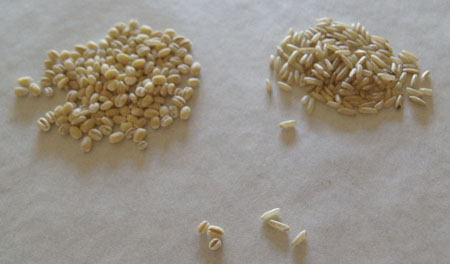 Below is pearled barley compared to the barley I found at Steamboat Mountain. I am pretty sure it is what I called hulled, pot, or dehulled barley in the above paragraphs, with the husk removed but not pearled, and considered a whole grain because it still has its bran and germ intact. (I don’t think it is the hull-less cultivar.) It is much darker than the Shiloh Farms pearl barley; below are the two compared, pearl on the left, hulled on the right.
Below is pearled barley compared to the barley I found at Steamboat Mountain. I am pretty sure it is what I called hulled, pot, or dehulled barley in the above paragraphs, with the husk removed but not pearled, and considered a whole grain because it still has its bran and germ intact. (I don’t think it is the hull-less cultivar.) It is much darker than the Shiloh Farms pearl barley; below are the two compared, pearl on the left, hulled on the right.

Nutrition
The values for pearl barley purchased from Shiloh Farms: 1/4 cup of barley has 160 calories, 7 grams fiber, and 4 grams protein.
From the nutritionalvalue.org site, I find that barley (hulled) has these RDAs: 12% niacin, 22% thiamin, 8% riboflavin, 8% vitamin B6, 2% vitamin K, 13% copper, 10% iron, 16% magnesium, 49% manganese, 13% phosphorus, 27% selenium, and 9% zinc.
Barley contains beta glucan, a soluble fiber, that has been reported to reduce cholesterol. (GoBarley website.) Recent research indicates that “barley’s ability to control blood sugar may be exceptional” and barley “reduces blood pressure”. (Oldways Whole Grain Council website.)
I found varied values for the glycemic index (GI) for barley. Remember: lower values are better for diabetics (indicate “slow” grains for sugar release), and under 55 is good for a grain in general.
The Glucose Revolution Pocket Guide to Losing Weight
Glycemic Index (GI) Guidelines for a Plant-based Diet Barley (Full Plate Living website) gives these values:
- porridge made from barley flour or dehulled flakes 63
- barley, rolled 66
LiveStrong values:
- cooked pearl barley 35
- hulled barley 20 to 22
Oregon State University
Cooking
Always consult the barley package if you have it. Otherwise, follow the instructions below. (Explanations follow the table.)
|
water |
time simmering |
| 1 cup pearl barley (Shiloh Farms) |
3 cups |
50-70 minutes |
| 1 cup pearl barley (Shiloh Farms) |
2 cups |
30 minutes in pressure cooker, high, fast release |
| 1 cup dehulled barley (not pearled) |
3 cups |
35 minutes in pressure cooker, high, fast release |
| 1 cup hull-less barley (Bob’s Red Mill) |
3 cups |
40-80 minutes |
I have two types of barley to cook: pearl barley and dehulled (pot) barley. The package of pearl barley says to cook 1 cup of pearl barley in 3 cups water 1 hour and fifteen minutes. My book, 1000 Vegetarian Recipes, says to cook 1 cup dehulled barley in 2 1/2 cups water for 1 hour and 20 minutes.
I experimented. I started with the pearl barley and my pressure cooker. I cooked 1 cup in 2 cups water for 35 minutes, high pressure, fast release. All of the water was absorbed, and the barley was sticky and very done. If I tried pearl barley in the pressure cooker again, I’d start with 30 minutes.
Note: 1 cup pearl barley yielded 3 cups cooked.
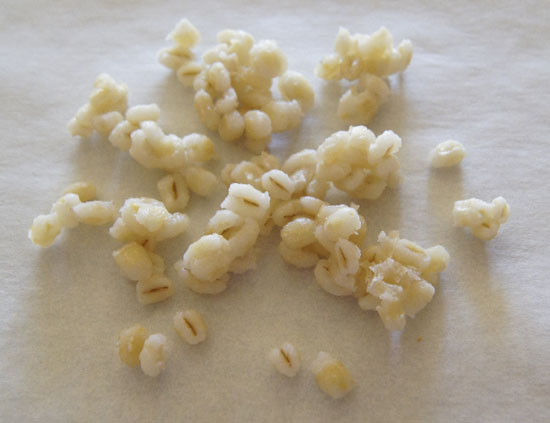 I cooked the dehulled barley in my pressure cooker, 1 cup barley and 2 cups water, for 30 minutes, high pressure, fast release. It was not done, so I cooked it another 5 minutes under high pressure, fast release. Perfect! Chewy and good. It had some water left and I drained it off. So, next time, 35 minuted in the pressure cooker.
I cooked the dehulled barley in my pressure cooker, 1 cup barley and 2 cups water, for 30 minutes, high pressure, fast release. It was not done, so I cooked it another 5 minutes under high pressure, fast release. Perfect! Chewy and good. It had some water left and I drained it off. So, next time, 35 minuted in the pressure cooker.
Let’s go back to the pearl barley. I want to make beef barley soup (I found this recipe on Cook’s Illustrated). I know my husband, and he would prefer the pearl barley. I wanted to cook the pearl barley in the soup itself so it could take up all of the flavors of the stock (my very good own beef stock) and the other ingredients of the soup, so I added it uncooked at the first simmer of the soup. I simmered the soup for 1/2 hour and checked the barley – it was not done. At 1 hour, though, it was just about perfect. I then left it standing off heat for another 1/2 hour and it was a lot softer than it was before I let it stand. In the future, I’d say, simmer Shiloh Farms pearl barley in a soup (or water) for about an hour, and it will be ready to serve immediately.
From my experiences above with pearl and dehulled barley, it is difficult to tell everyone exactly how to cook this grain. (And add in that I haven’t even tried a hull-less cultivar of barley, such as sold by Bob’s Red Mill – that package says to cook that cultivar 40-80 minutes. I also didn’t try instant barley.)
Experiment! And then if you like it, always buy the same type of barley. Keep in mind that it might take over an hour to cook barley. Or, if you buy “instant” barley, it might take only 20-30 minutes.
Recipes
Recipes for barley abound on the internet. But in my own house? Well, my digitized collection of recipes calls for barley flour in tortillas, and for whole barley in beef soup. That’s it. In my cookbooks? A few of my health food cookbooks have recipes for whole barley and for barley flour. That’s it.
I have an unopened package of barley flour that King Arthur Flour sent me when I ordered “ancient grain flour”. I opened it and added a half cup to My Daily Bread this week, but the loaf failed to rise well in the pre-baking step and baked into a dense (but well-flavored) loaf. The package suggests using barley flour to make soft tortillas – I think that’s the recipe to try next, or I’ll add it to muffins, or use less than 1/2 cup in a loaf of bread.
But online? Recipes abound. In general, barley can be used anywhere rice is used. Or, like other intact grains in tabouleh-style salads. I’m listing some recipe links below.
GoBarley site recipes
- Sweet and Sour Barley Casserole
- Sausage, Lentil, and Barley Soup
- Zucchini, Bean, and Almond Salad
- Carrot Cake Barley with Walnuts, Raisins, and Greek Yogurt
- Soft Barley Pretzels
Cook’s Illustrated
- Light Barley Risotto
- Farmhouse Vegetable and Barley Soup
- Barley Risotto with Roasted Butternut Squash
- Beef and Barley Soup for Two (I made this soup using pearled barley and it was great)
Fanatic Cook
Bob’s Red Mill
Old Grains Council
- Bacon Sautéed Barley with Arugula
- Baked Chicken with Apples and Barley
- Barley Antipasto Salad
- Barley, Pineapple, and Jicama Salad with Avocado
- Barley-Stuffed Bells
- Thai Barley Stir-Fry
- Strawberry Barley Scones
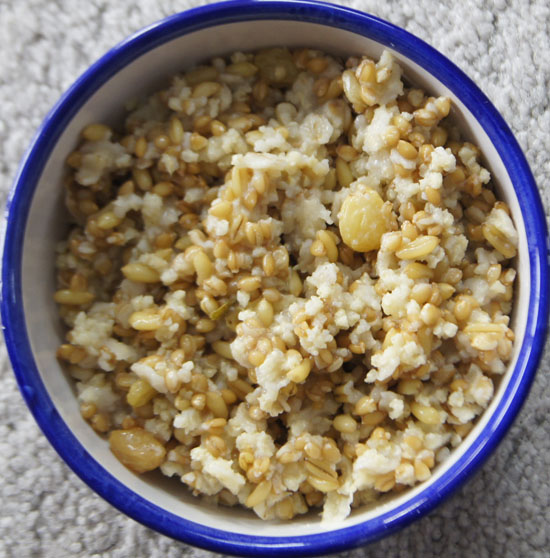

 Millet compared to medium grain brown rice:
Millet compared to medium grain brown rice:
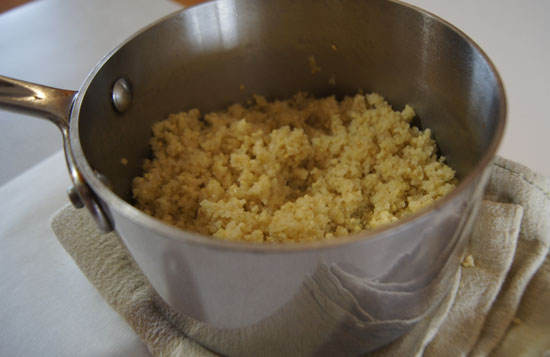 I think it is beautiful! It tastes a tiny bit like corn, and not all the seeds cooked evenly, giving it just about the perfect amount of crunch. (“Crunch” is an important factor in my food tasting!)
I think it is beautiful! It tastes a tiny bit like corn, and not all the seeds cooked evenly, giving it just about the perfect amount of crunch. (“Crunch” is an important factor in my food tasting!)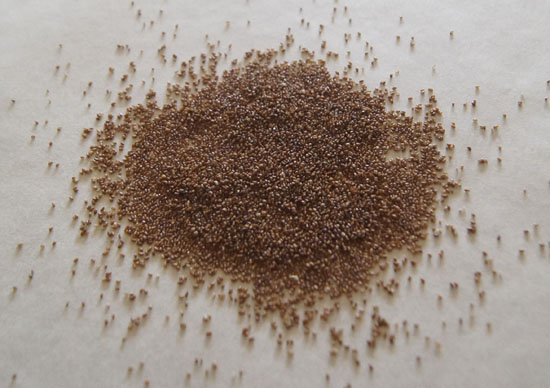
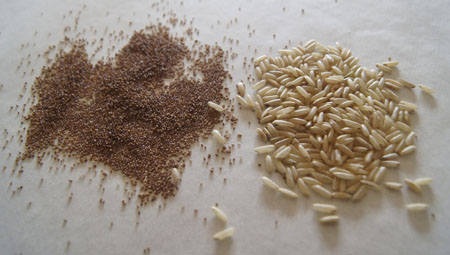
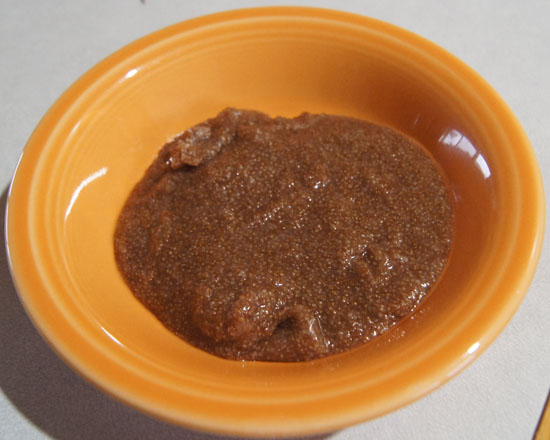
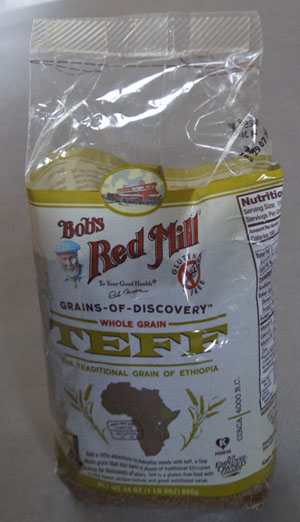
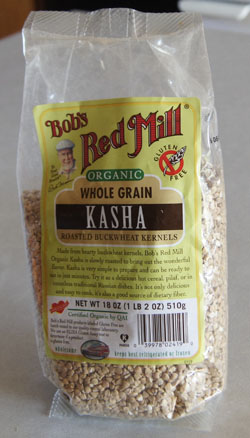
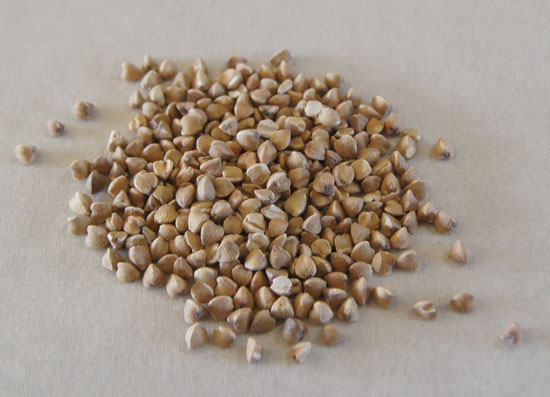

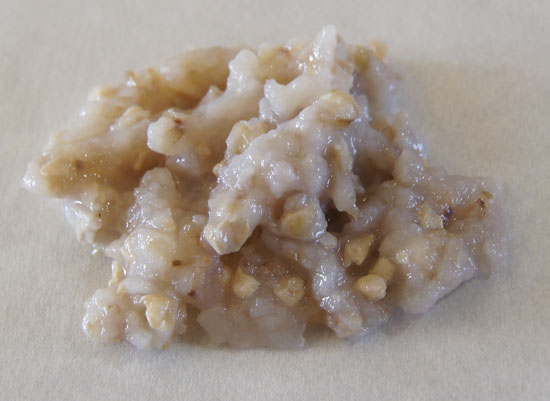


 Below is pearled barley compared to the barley I found at Steamboat Mountain. I am pretty sure it is what I called hulled, pot, or dehulled barley in the above paragraphs, with the husk removed but not pearled, and considered a whole grain because it still has its bran and germ intact. (I don’t think it is the hull-less cultivar.) It is much darker than the Shiloh Farms pearl barley; below are the two compared, pearl on the left, hulled on the right.
Below is pearled barley compared to the barley I found at Steamboat Mountain. I am pretty sure it is what I called hulled, pot, or dehulled barley in the above paragraphs, with the husk removed but not pearled, and considered a whole grain because it still has its bran and germ intact. (I don’t think it is the hull-less cultivar.) It is much darker than the Shiloh Farms pearl barley; below are the two compared, pearl on the left, hulled on the right.
 I cooked the dehulled barley in my pressure cooker, 1 cup barley and 2 cups water, for 30 minutes, high pressure, fast release. It was not done, so I cooked it another 5 minutes under high pressure, fast release. Perfect! Chewy and good. It had some water left and I drained it off. So, next time, 35 minuted in the pressure cooker.
I cooked the dehulled barley in my pressure cooker, 1 cup barley and 2 cups water, for 30 minutes, high pressure, fast release. It was not done, so I cooked it another 5 minutes under high pressure, fast release. Perfect! Chewy and good. It had some water left and I drained it off. So, next time, 35 minuted in the pressure cooker.

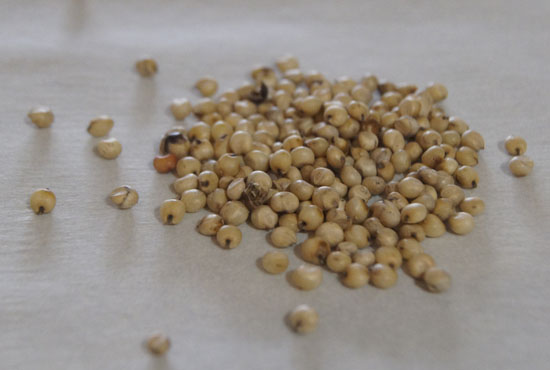 Sorghum and brown rice:
Sorghum and brown rice: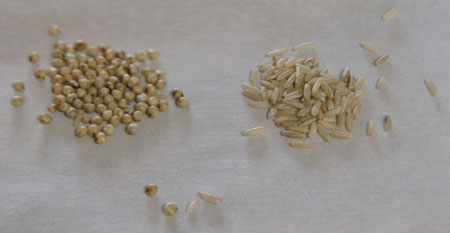
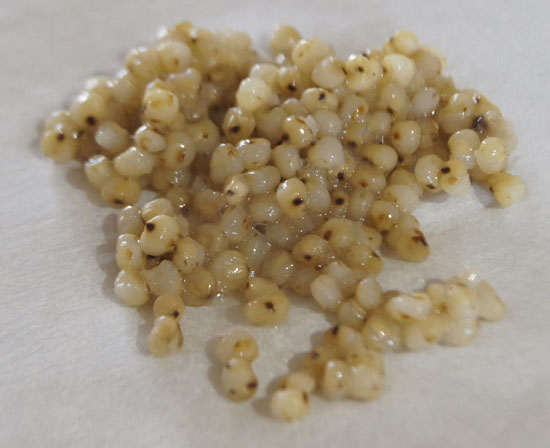
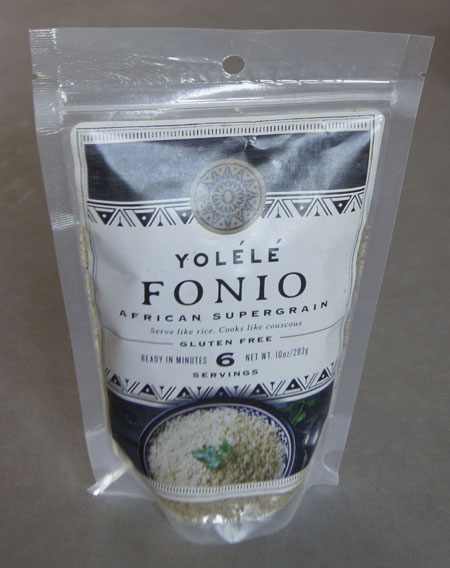
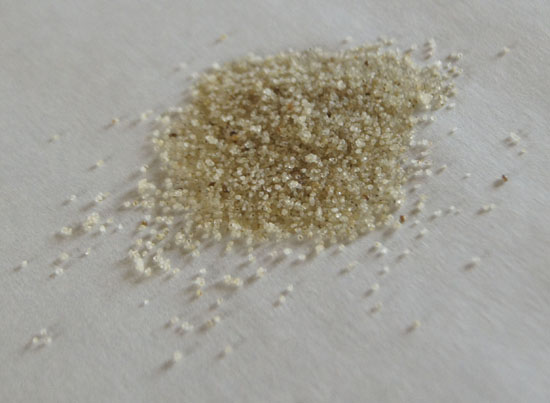 Fonio compared to medium grain brown rice:
Fonio compared to medium grain brown rice: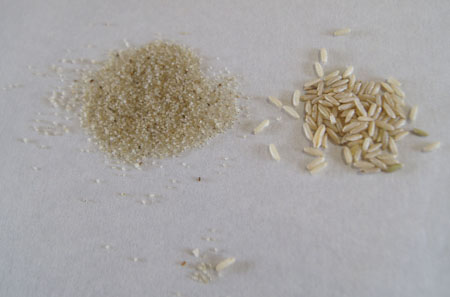 It is really tiny! The Yolélé package states that the fonio they sell is pre-cooked. I am not sure if this process is similar to the production of
It is really tiny! The Yolélé package states that the fonio they sell is pre-cooked. I am not sure if this process is similar to the production of 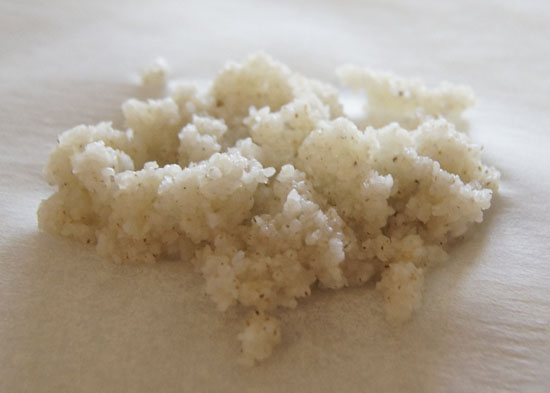

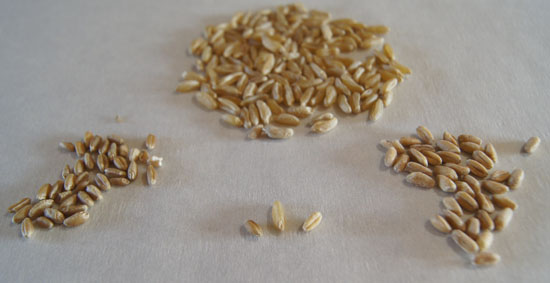
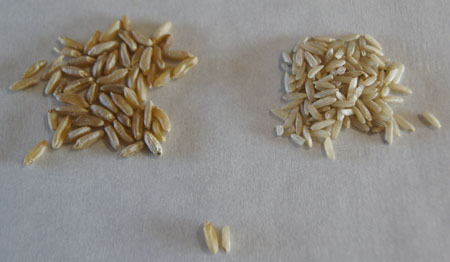
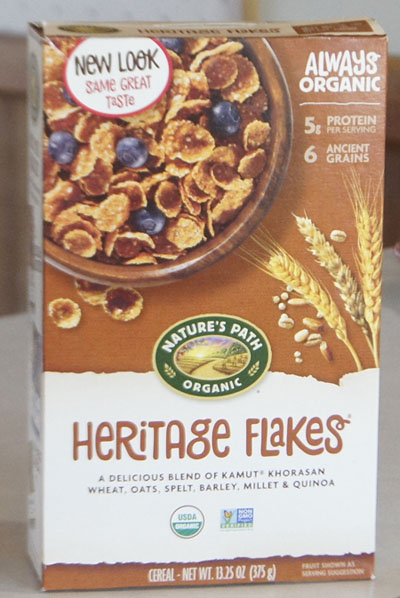 Nutrition
Nutrition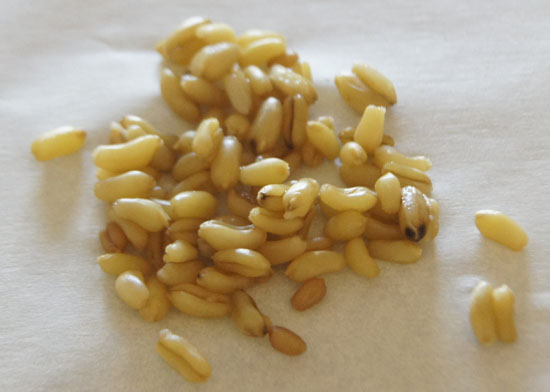

 Compared to medium grain brown rice:
Compared to medium grain brown rice: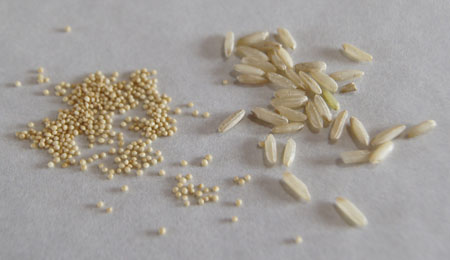
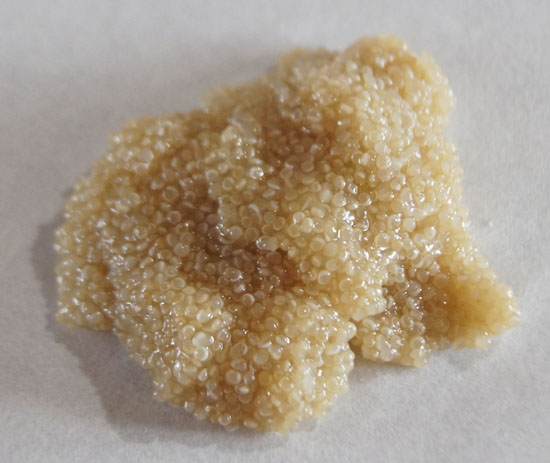 I note from one site that you should rinse the cooked amaranth with water before serving or adding to recipes. That might make it have a more pleasing texture. But, you’d have to use a pretty fine sieve to rinse it.
I note from one site that you should rinse the cooked amaranth with water before serving or adding to recipes. That might make it have a more pleasing texture. But, you’d have to use a pretty fine sieve to rinse it.
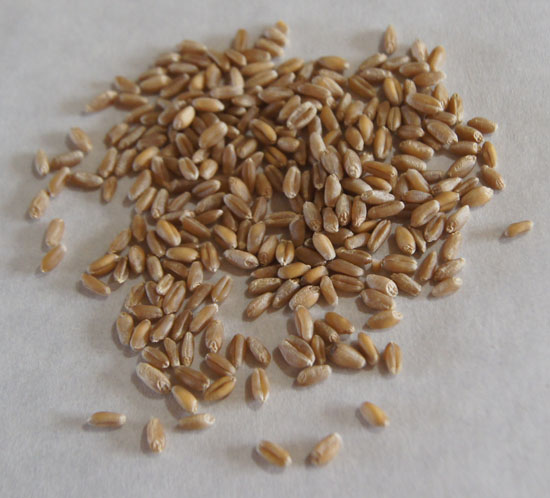
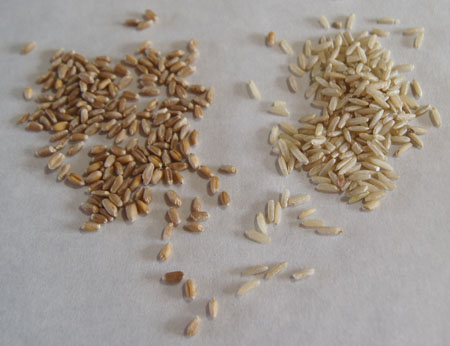 Here are sprouted wheat berries. They are kind of good “as is”, but are better in breads. (I sprouted these wheat berries from the berries I bought in a bulk-bin.)
Here are sprouted wheat berries. They are kind of good “as is”, but are better in breads. (I sprouted these wheat berries from the berries I bought in a bulk-bin.)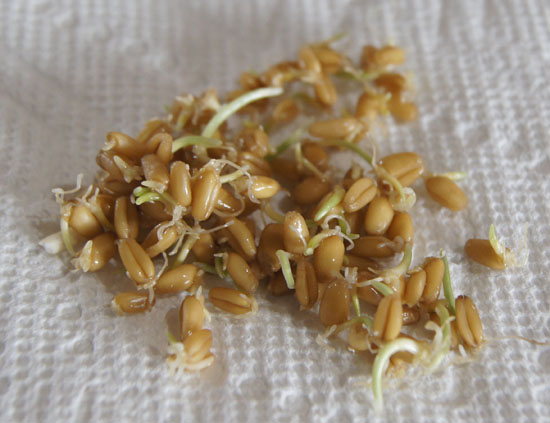 Nutrition
Nutrition I liked these! They are as nutty tasting as they look. Crunchy and full of flavor. But tastes differ, and my husband didn’t like them much at all when I used them as a substitute for rice. He called them “rubbery”.
I liked these! They are as nutty tasting as they look. Crunchy and full of flavor. But tastes differ, and my husband didn’t like them much at all when I used them as a substitute for rice. He called them “rubbery”.